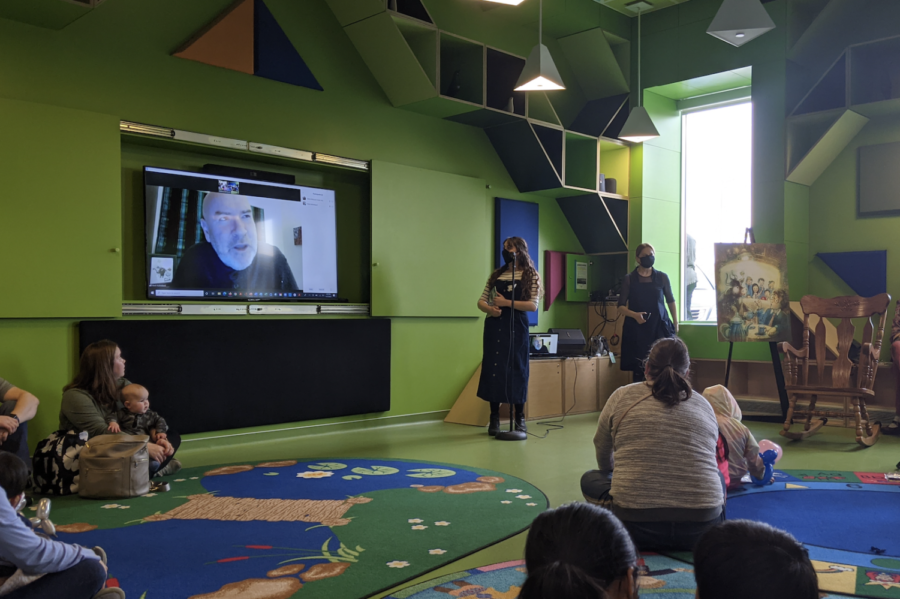Flyway: Journal of Writing and Environment holds a launch party for its new book
November 8, 2021
Iowa State based publisher, Flyway: Journal of Writing and Environment, held a launch party at Ames Public Library for the release of their first book, “A Moo Cow Came Traveling.” The childrens book was written by Mark Mulholland and illustrated by Dorothia Rohner, who were both present at the event, although Mulholland attended virtually from his home in France.
In the library’s story time room, parents and children had gathered to take part in the event. A balloon artist captivated the kids attention and parents mingled with each each other as well as Rohner and some of the Flyway editors.
Having orchestrated the event, the editors even took it upon themselves to entertain some of the kids when technical difficulties arose around Mulhollands Zoom call. The Flyway editors, Emily Riley and Zoë Fay-Stindt (who was dressed as a cow) made rounds in the room playing rock paper scissors with kids and awarding them with stickers.
Flyway cycles through their managing editors every year, Riley, had helped to edit the book throughout last year and stayed as a managing editor to help see the project through fruition. Other editors of the book were John Carter, English graduate student at Iowa State, and Debra Marquart, distinguished professor of English and senior editor of Flyway.
The event started with a brief virtual Q&A with Mulholland, who explained what makes the Moo Cow featured in his story so special.
“As we all know, he’s a very special cow,” said Mulholland. “I like best his genuine observation and love for the small things of our lives, you know, the color of a front door the whistling sound of an old women’s breath, time, sound, music, tea greetings, conversations, mystery thinking and especially Irish dancing.”
Mulholland also commented on some of his other short stories, which highlight similar ideas to “A Moo Cow Came Traveling.” Mulhollands stories are meant to point out different aspects of people’s lives and throw the aspects back at them to allow for new perspectives on small details of daily life.
After the Q&A was a reading of a passage from the opening of the book.
Also featured at the launch party were posters with illustrations from the book blown up to allow for in-depth observations. Rohner explained some of the thought behind her artwork featured in the book.
“…The pub was so descriptive … I started, the more I dove into it and users that were so specific, I realized this is a real place,” said Rohner “Then I started following the pub he was describing, with a pub that was in the same town. So what’s on the cover of the book is a kind of an image of the town.”
Rohner’s illustrations are complemented by a style that reflects the power of observation back to the reader. Small speckles resembling cracked paint give backgrounds a rustic sense of wonder, which brings out the peculiar characteristics of the Moo Cow and his interactions.
“I didn’t want it too realistic and I like to if sometimes if you put too much detail, it takes away from what’s the story is happening,” said Rohner “I don’t like to render things like this is a lamp [etc.] I like the scene to kind of go together maybe like the Impressionist it’s an expression of something. So the crackle on the outside was to me, like, there’s always this thing of magic and sparkle. So I added that last and it seemed to just make the whole scene kind of come together.
“A Moo Cow Came Traveling” is the first fully-illustrated book published by Flyway: Journal of Writing and Environment. Riley and Carter explained a little bit about the process that went into publishing the book.
“This book was really fun and playful, so that had your attention immediately,” said Riley. “It actually caused quite a stir among some some of our editors, because we couldn’t agree on how to read it and finally Doug said, ‘What if it’s a children’s book?’ And then it just clicked.”
Deciding to publish the short work as a children’s book meant that Flyway would need to overcome a whole new set of challenges, having only dealt with digital publishing in the past. Flyway’s editors were challenged with finding an illustrator as well as finding out how to get the book printed.
Regardless of how the editors felt about the story, they knew it did not belong on the digital journal, rather they wound up creating an entire new publishing house in order to introduce the book to the world.

















